Warrior mice, revolutionary pigs, scientifically-minded chimpanzees, and radioactive elephants—some of the most memorable (and ironically, the most human) stories feature anthropomorphic animals at their core. Political history, racial allegories, class tensions, and environmental warnings spring to life when ordinary animals are re-cast as, say, Leon Trotsky, or a heartsick sniper fighting an endless war…
Below, we’ve corralled some of the best animal characters genre fiction has to offer. Let us know your favorites in the comments!
Barsk: The Elephants’ Graveyard and The Moons of Barsk by Lawrence M. Schoen
Buy the Book
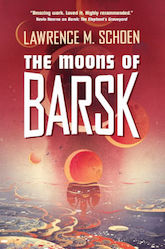

The Moons of Barsk
A fatherless boy named Pizlo is a member of the Fant—the race of anthropomorphic elephants that have been banished to Barsk, considered a backwater by the rest of the uplifted animals of the galaxy. Humans are a distant memory, but the various animal descendants have proved adept at populating space without our interference. Now an offworld group is trying to break into the Fant’s control of their one resource, a medicine called koph. While his voices push him toward an uncertain future, his father’s best friend, the Fant’s Speaker With the Dead, is using the spirits’ answers to uncover secrets that those in power would prefer to keep hidden. Here anthropomorphic animals and far-future sci-fi combine to tell a heartbreaking story of the elusiveness of truth, and the prison of memory.
Animal Farm by George Orwell
Buy the Book
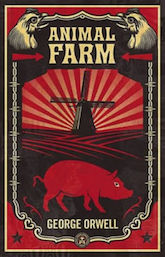

Animal Farm
Obviously, this one holds a place of honor on any list of talking animals. Orwell’s mini-allegory of the Bolshevik Revolution casts pigs as different members of the communist party, while the hardworking horses, cows, and hens stand in for the peasant class—exploited first by feudalism and then by the Party itself. The dogs, once loyal to the humans, become the pigs’ military over the course of a generation, while the sheep blindly follow whoever is in charge. Also, I’m pretty sure the donkey is supposed to be Walter Benjamin? Anyway, never trust anything that walks on two legs! And never give a pig liquor. It turns out that doesn’t end well.
The Island of Dr. Moreau by H.G. Wells
Buy the Book
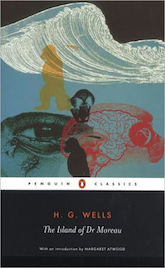

The Island of Dr. Moreau
Speaking of never trusting anything with two legs… poor Dr. Moreau just wants to be left in peace on his island, where he can genetically modify every animal he can get his hands on. Is it so wrong to want an army of Beast Folk? Unfortunately, the rest of the world isn’t so keen on the Beast Folk plan, so Moreau must pursue perfection alone. His latest experiment, a Puma-Man (ahem), also turns out not to be wholly onboard with his uplifting, and things go a bit pear-shaped. Did I mention that giving transformed animals liquor is a bad idea? Did that come through? Wells used this horrific tale as an attack on the practice of vivisection, as well as pointing out that humans seemed to be slipping a bit in their civilized ways.
The Only Harmless Great Thing by Brooke Bolander
Buy the Book
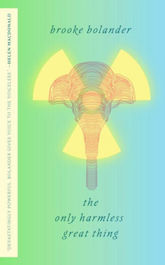

The Only Harmless Great Thing
In an alternate past, elephants are recognized as sapient creatures by their ability to communicate through a trunk-centric sign language called Proboscidian. That doesn’t stop the folks at US Radium from putting a troublesome Indian elephant to work in the factories alongside their female employees, who are slowly dying of radiation poisoning. In an alternate present shaped by a rewriting of Topsy’s tragic death at Coney Island, a young woman attempts to convince the elephants to change their genes and their very purpose in order to help prolong the human race. The fact that she doesn’t speak Proboscidian and must rely on a translator only underscores the exploitative relationship between the (as the poetic interludes describe it) “flat-faced pink squeakers with more clever thinking than sense” and the Many Mothers with “memories longer than stone.” Read an excerpt from the novella here.
The War with No Name Series by Robert Repino
Buy the Book
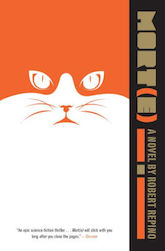

Mort(e)
One day, Morte is an ordinary housecat. He has a crush on a neighbor dog named Sheba, and he loves lying in the sun. But then things start to change. He begins to think more complex thoughts, and chafe against the restraints of life as a cat. Something terrible happens to Sheba’s puppies, and the dog disappears. Suddenly a new world is revealed, one ruled by the Colony, hyper-intelligent ants who want to eradicate the human race. Morte takes on a new role as a warrior, and seems to be dedicated to this new animal-friendly world. But his true motivations are more complicated than that, and when a human claims to know where Sheba is, Morte has to decide what he’s willing to risk for his friend. The book skillfully weaves a post-apocalyptic narrative into an allegory about human society, along with a dash of Unstoppable-Virus-That-Must-Be-Contained. The first two books in the series, Morte and D’Arc, find their true heart in the story of Morte’s unwavering interspecies love for Sheba, while the third Culdesac, follows the adventures of a murderous Bobcat.
The Builders by Daniel Polansky
Buy the Book
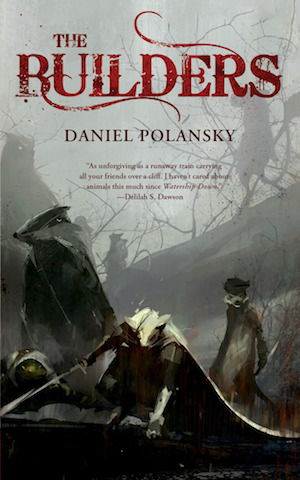

The Builders
A missing eye… a broken wing… a stolen country.
Yeah, the last job didn’t end well.
The Captain’s company has kept a low profile since then, eking out an existence in the shadow of the war they lost. But that doesn’t mean the memories have faded, or even that the wounds have scarred. It’s all still fresh to the Captain. He finally sees a shot at vengeance, but how many of his old company are left? And how many will join the old mouse on one last tour? Opossum sniper Boudica, stoat assassin Bonsoir, and the sinister salamander named Cinnabar all answer his call, but will they be enough to settle the score?
The Jungle Books by Rudyard Kipling
Buy the Book
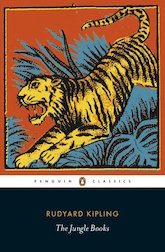

The Jungle Books
Rudyard Kipling’s stories of survival in the jungles of India have inspired several live-action movies (including one that stars Scarlett Johansson as Kaa, which, frankly, terrifies me) the classic Disney cartoon and, wonderfully, Neil Gaiman’s The Graveyard Book. At the heart of the stories is a man-cub named Mowgli who has to learn to live among various slightly anthropomorphized beasts, including Bagheera the regal panther, Baloo the slacker bear, and Shere Khan, the kick-ass tiger who is vilified for acting like a tiger. The book also includes the heroic tale of Rikki-Tikki-Taavi, so if you want to weep for a few straight hours, Kipling has you covered.
Saga by Brian K. Vaughan and Fiona Staples
Buy the Book


Saga Volume 1
The world of Saga includes plenty of magical beings, robots, and talking animals, but the one we truly love is Lying Cat. A giant blue space cat, she’s the companion to a bounty hunter known as The Will and helps him on his jobs by loudly announcing “LYING” whenever someone tries to evade the truth. She’s also a fairly effective enforcer, taking down armed men when necessary. Initially used as a sort of dark comic relief, Lying Cat won our hearts by providing comfort to Sophie, a young girl rescued from a particularly creepy pleasure planet. Later—because we can’t have nice things—we get a single, terrible panel of backstory that throws all of Lying Cat’s life into stark relief.
Tailchaser’s Song by Tad Williams
Buy the Book
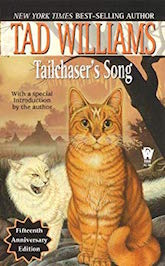

Tailchaser's Song
Tad Williams’ first novel follows a ginger tomcat named Fritti Tailchaser as he navigates life among other anthropomorphized animals, each with their own cultural traditions, mythologies, and languages. The epic begins when Tailchaser decides to leave the Meeting Wall clan and investigate the mysterious disappearances of cats. The journey soon becomes a full-fledged quest as he gains friends (including the adorably-named kitten Pouncequick, and the somewhat-less-adorably-named crazy cat, Eatbugs) and enemies as he followsthe path to the Royal Court. Tailchaser must face off with villainous Lord Hearteater and the dog-like monster Fikos to save his fellow cats from extinction.
Vic and Blood by Harlan Ellison
Buy the Book


Vic and Blood
Harlan Ellison’s story cycle featuring Vic (the Boy) and Blood (the Dog) isn’t so much an allegory as it is a bleak postwar dystopia, but there is enough satire in the plot, and enough acidic running commentary from Blood, that we felt like it needed to be here. Vic is the child of scavengers, with no education and little sense of morality. He does what he needs to survive, and since puberty has recently struck, he also does whatever he needs to find women, whether they’re willing or not. He and Blood develop a symbiotic relationship—Blood smells out women, and Vic steals food to share. L.Q. Jones’ 1975 movie adapts the second story in the cycle. Now, you’re going to be shocked by this, but Harlan Ellison voiced some disagreements that he had with the film adaptation, particularly calling out the “moronic, hateful, chauvinist” final line.
Mouse Guard by David Petersen
Buy the Book
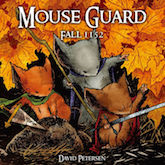

Mouse Guard Volume 1: Fall 1152
Mouse Guard is a long-running comic series about a blissfully human-free medieval world, and the complex society built by sentient mice. The mice managed to overthrow an evil weasel and live in relative peace, and the “Mouse Guard” formed as a brotherhood to protect civilians from other predators, escorting them as they travel through lands that may be unsafe.
The Mouse Guard is made up of a vast array of characters, from Gwendolyn, the leader who oversees the MG’s operations to her assistant Roibin (who is also a poet), to Celanawe, The “Black Axe,” whose prowess in battle has passed into legend, to Sadie, a younger mouse who returns home from the Guard outpost on the Easter Shores with a terrifying skill with daggers. The books riff on the conventions of medieval adventure, while creating a portrait of a complex society that can contain both brutal violence and adorable whiskers.
Carmen Dog by Carol Emshwiller
Buy the Book
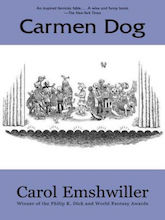

Carmen Dog
In Carol Emshwiller’s picaresque adventure, women begin turning into animals and animals suddenly become women. Pooch, until recently a lovely golden setter, finds herself turning into an equally lovely woman, while her mistress is taking a turn for the snapping turtle. As a loose wolverine rages through the city streets, baffled men try to figure out what’s happening, baffled animals try to adjust to their new lives, and Pooch is forced to kidnap her mistress’ (human) baby and go on the lam to keep it safe from its turtle-mom’s jaws. But now that she’s human Pooch is just starting to figure out what she wants to do with her new life, and that doesn’t include acting as an adoptive mother—she wants to be an opera singer.
Carmen Dog deftly mixes anthropomorphic animals, feminist critique, and sharp humor into a cult class that inspired Pat Murphy and Karen Joy Fowler to create the James Tiptree Jr. Memorial Award.
La Planète des Singes by Pierre Boulle
Buy the Book
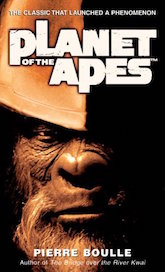

The Planet of the Apes
La Planète des Singes—in English, Planet of the Apes—has been adapted into three different film universes that riff on the book’s original premise: a far-future couple happen upon the writings of the human journalist Ulysse Mérou, who documents his time trapped in an off-planet ape society, dwelling on the way it stratifies itself between Gorilla, Orangutan, and Chimp. The 1960s films largely turn the discussion of class into one of racial discrimination, while the current film series shifts the primary focus onto animal rights. (The less said about the Tim Burton reboot, the better.) All versions also touch on the question of what makes us human, in large part by focusing on nuanced ape characters—from the scientifically-minded Zira and Cornelius, to the sympathetic Caesar.
Watership Down by Richard Adams
Buy the Book
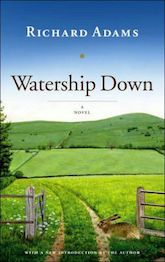

Watership Down
Possibly the most traumatic single book on a list of traumatic books, this is an epic adventure starring rabbits. Watership Down began life as a story Richard Adams told to his daughters, but with research he expanded into an epic the echoes the stories of Ulysses and Aeneas. Fiver, a psychic rabbit, has a vision that his warren is going to be destroyed. Only a few rabbits—including his brother Hazel—believe him, embarking together on a quest to find a new home, facing many dangers along the way. Finally, they reach the Watership Down of the title, set up camp, and begin exploring the possibilities of liberating some does from a nearby hutch. The only problem is, the powerful warren next door might try to take it from them… hence horrifying RABBIT WARFARE. Richard Adams rejects the idea that the story is an allegory, but it does act as a commentary on political and military struggles, and the ways a society that focuses on military might to the exclusion of all else might not be the best society, for rabbit or man.
Maus by Art Spiegelman
Buy the Book
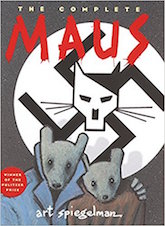

The Complete Maus: A Survivor's Tale
On second thought, maybe this is the most traumatic book on this list… In Maus, Art Spiegelman took his father’s stories of the Holocaust and recast them with talking animals: Jews = mice, Germans = cats, and Americans = dogs. This manages to both make the story more immediately readable, and somehow even more horrific, especially when you realize that Spiegelman was drawing on real Nazi imagery that cast Jews as a plague of rats, and that Zyklon B was initially manufactured as a pesticide. This book more than any other convinced a generation of non-comics readers that maybe the medium was something they should take seriously, paving the way for the graphic novel boom of the 1990s and beyond.
Earlier versions of this list were published in November 2015 and January 2018










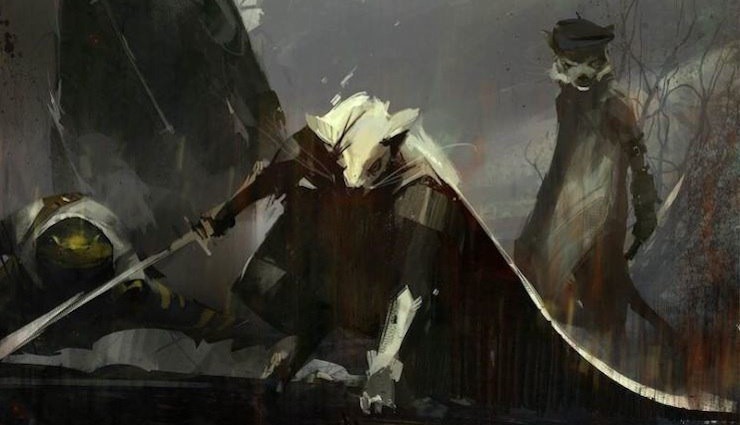
None of the Redwall books by Brian Jacques?
While waiting in a bus station about a year ago, I picked up a children’s book from the “read-until-you-wait” shelf there (seemed the most interesting there was at the time) and it turned out to be quite adorable and interesting. It, too, spoke of anthropomorphized animals living in a forest kingdom. I went to Google-search for it now to make a reference and found it to be none other than one of the “Redwall” books already mentioned by David H Olivier @1.
Ed: from the top of my head, how’s also “The Hundred and One Dalmatians” by Dodie Smith and “The Sheep-pig” by Dick King-Smith? Children’s stories, yes, but so sweet and nice.
What – no Maurice!!! After all he is amazing – and so is the book (Terry Pratchett;s The Amazing Maurice and His Educated Rodents) . May a plague of rats invade your house and tap dance across your kitchen.
I’d have mentioned the Duncton Moles books by William Horwood, the great heroic epic and mythology of the UK but as told via moles. I’d also mention House of Tribes by Gary Kilworth which is a version of the mystic’s journey but with mice.
And of course, The Amazing Maurice and His Educated Rodents by the late and great Terry Pratchett. It is what you get when you cross The Pied Piper tales with a Hammer Horror and a dash of Minder.
I must remind the readers that Watership Down contains no anthropomorphic animals: The rabbits; and all animal characters, behave at all times not as humans, but in the manner of animals that could be best interpreted by the human author. The characters do not wear clothing or walk upright on two legs (other than the birds); they do not fight with human weapons or even human-like weapons adapted for animal use; the human world to them is consistently unknown, disorienting and dangerous. Rather than a story of animals taking on human-like characteristics, it is a story of animals trying to survive in a world that requires continual vigilance and with the ever-present possibility of death resulting from the slightest mistake. While humans may today believe they live in a world that shares these traits, the direct, no-opportunity-for-a-second chance consequences of not being 100% alert and aware 100% of the time, no longer applied to humanity after the extinction of the Smilodon; cave bear; dire wolf; and other mega-predators; and their replacement with the latest mega-predator, man.
If you like Watership Down and cats, you must check out Nilanjana Roy’s duology–The Wildlings is the first book, followed by The Hundred Names of Darkness. It’s the cat-centered fantasy I’ve always wanted.
Diane Duane’s Feline Wizardry series (an adjunct to her Young Wizards books, beginning with The Book of Night with Moon), about a group of, yes, cats who are wizards. And the third book (The Big Meow) is finally available from her website!
I would have assumed Narnia would have made this list.
No mention of Neal Barrett’s Aldair novels?
I’m not sure this really belongs, but it’s one of my favorites so I’m adding it, A Night in the Lonesome October, by Roger Zelazny. Very weird people doing very strange things as told by their familiars. But it’s so much more
Seanan McGuire’s Aeslin mice, in the InCryptid series.
A gentleman named Michael Swanwick has written a series of stories and novels regarding a certain Sir Blackthorpe Ravenscairn de Plus Precieux (alias, Surplus). I’m sure he has had stories published on this very site. Perhaps on an updated list you could include Dancing With Bears and Chasing the Phoenix.
I kind of agree that Watership Down is not about anthropomorphic animals, but if it belongs here, so does Fifteen Dogs, And it’s far more traumatic than Watership Down. As for Maus, it felt like a cheap gimmick, and it was so poorly lettered that I had a hard time even making out the text.
Ursula Vernon’s “Digger” – a graphic novel about a wombat engineer who is very, very annoyed at having been dragged into an Adventure! Among those she encounters are a tribe of hyenas, whose mythology is very accurately based on real hyena biology.
The best part? The whole thing is available online! http://diggercomic.com/
Or, for lighter reading, her “Hamster Princess” series, starting with “Harriet the Invincible” – delightfully twisted takes on fairy tales. Harriet has a Sleeping-Beauty type curse on her, but realizes that since the curse needs her to be alive for it to take effect on her birthday, she is literally invincible until then!
What of Brin’s Uplift books?
Sherri S. Tepper’s The Family Tree, which if I recall correctly has any number of animals who have, much as in Brin’s Uplift books, become intelligent — plus it’s a great story!
I know I’m sticking to the good ol’ classics here, but “Wind in the Willows” and “Winnie-the-Pooh”? And, again children’s stories, but I just love “The Woodland Folk” series by Antonio Lupatelli (under the pseudonym Tony Wolf).
Watership Down’s animals are very much anthropomorphic. Adam’s rabbits don’t have human clothes or tools or walking stance, but they are definitely humanized in the shape of their minds; they have language, names, tales and myths, a limited counting-system, and a few are even experimenting with poetry and visual art. Real rabbits probably don’t have the right kind of brain for this. I’d say anthropomorpic animal fiction is a spectrum, combining different human and nonhuman properties in its characters according to the natures of the stories and the imaginations of the tellers.
I loved to read Andre Norton’s Breed to Come when I was a kid. There were The People (cats), Barkers (dogs), Rattons (rats) and Tuskers (wild pigs) in a world humans had left behind. There seemed to be something about the planet that made humans mad and warlike for some reason, as I recall. I mostly enjoyed the feline archeologists exploring the ruins of ancient human cities looking for technological wonders.
Just finished The Builders. Nice read… sort of No Country For Old Mice.
Virtually every story in Andre Norton’s anthology: Catfantastic: Nine Lives and Fifteen Tales
Wow! I would understand forgetting about the incredible graphic novel “We3” when you have “Saga”, but no “Redwall” books and no “Narnia” books?! Serious fail.
Many of Andre Norton’s books included sentient animals though I think Breed to Come is the only one where they are the main characters.
Robert O’Brien’s Mrs. Frisby and the Rats of NIMH. Mrs. Frisby seeks help for her sick child from Nicodemus and his advanced society of intelligent rats that escaped from a test lab. I had to look it up, but the two sequels were written by his daughter Jane Leslie Conly. It’s been a while but I remember liking the sequels too.
An interesting follow-up to this (or has it been done by Tor already?) would be, animal companions in fantasy and sci-fi – think Oy from The Dark Tower or the otak from A Wizard of Earthsea…
@Otterpoet: I read that one recently too! Fantastic read. No Country For Old Mice, Ha! Spot on.
I’m also a bit stunned at the lack of a mention for Ursula Vernon’s Hugo Award Winning comic Digger.
Anyway, if you guys like these stories, check out a few more excellent, underrated anthropomorphic works by these lesser known authors. I’m not great at summaries, but the links have them:
God of Clay, by Ryan Campbell https://www.amazon.com/God-Clay-Fire-Bearers-Book-ebook/dp/B00NZ6MATU/
Kismet, by Watts Martin https://www.amazon.com/Kismet-Watts-Martin/dp/1614503397/
and Summerhill, by Kevin Frane https://www.amazon.com/Summerhill-Kevin-Frane/dp/1614501033/
I can’t believe that C. J. Cherryh’s Chanur series was left off of this list. Spacefaring Cats, Apes, Rats, multipart-brained Snakes whose speech has to be decoded as a matrix and have symbiotic kind-of-arthropods, and…(I don’t even know what Knnn are — I don’t think any of the oxygen-breathing species do…) all in a trade compact which gets along mostly just fine, thanks…and then humans show up…. It’s a rollicking tale, written by an SF Grandmaster in her prime. It even has a strong female cast, and a genderflipped commentary on contemporary gender politics: The felinoid species males are forbidden from going into space: They’re considered to unstable and aggressive. Which…leads to a major plot cliffhanger later on in the series. Don’t overthink it, don’t nitpick it to death, enjoy the ride, and hang on for dear life. It’s an extraordinary SF-fairytale with starships instead of dragons and humans instead of fae. And…in a multispecies civilization where no species makes war (at least in space) on its own kind, what does it mean that this new…human…race…does?
In addition to all the points made by @18, Watership Down shows a very human tyrant and security apparatus — unfortunately more relevant today (at least in the English-speaking world) than it was when written.
@28: I don’t think Chanur qualifies; I do not see the characters bound by the qualities or limitations of animals. Yes, I know anthropomorphism stretches these — but ISTM that it starts with the animal qualities as a frame and definition, where Cherryh was not. I think that’s why the Knnn in particular can’t be fit into the animal model; she was building aliens, who we Procrusteanize into animal models at our peril.
Hello? The Panzerbjorn from “The Golden Compass” trilogy.
What! No Cordwainer Smith Instrumentality stories? The Ballad of Lost C’mell and others. The Game of Rat and Dragon etc.
Hmm… Stephen Boyett’s Architect of Sleep was noticeably absent, as was his Ariel and Elegy Beach. Definitely Architect deserves to be on this list, but the other two did have some fantasy animals talking and interacting with humans. Also Alan Dean Foster’s Spellsinger series abounded with anthropomorphic animals.
I’ll cast a vote for Fire Bringer, by David Clement-Davies.
I also third Digger, and Redwall’s Mossflower was a formative childhood story.
@31: C’Mell, B’Dikkat, E’Telekeli et al were not animals; they were humanoids with some animal genes/characteristics. (“Smith” was a history professor in real life; biology was not his strong point.) The cats in “The Game of Rat and Dragon” are sentient but perceive and behave as cats, hence the title.
The Wind in the Willows is classic anthopomorphism; one can argue about whether the “Piper at the Gates of Dawn” chapter is enough to pull it into genre.
28,29, I might say that the alienness of the aliens was a deconstruction of the tendency to thinking of aliens as “Talking Lions” or “Intelligent Apes” but I wouldn’t be entirely certain without consulting with the author.
Though I would say that the Kif do have a lot of internal conflict, if it’s not war, it’s because they aren’t organized enough in general.
Thanks for this. Just bought the Builders and Tailchaser’s Song. Both sound great.
Some excellent books here, but a great miss in not listing Bryon Talbot’s fabulous Granville graphic novels, not to mention Joann Sfar’s The Rabbi’s Cat.
Not sure if I can take this list seriously without any nod towards Hearne’s Oberon…
@33: I was going to suggest one of David Clement-Davies’ other fantastic novels, “The Sight”.
Another suggestion I would make is for Kathryn Lasky’s “Guardians of Ga’Hoole” series.
If we count graphic novels and webcomics, comic strips also count. So Pogo definitely belongs on the list! :)
Another vote for Maurice.
Also Verjak Paw by S F Said.
Walter R. Brooks from the 30s to the 60s wrote about Life on the Bean Farm and its environs of upstate New York. Mainly centered on the adventures of Freddy the Pig, an autodidact, who learned to fly, created a bank to ensure that aged animals could have a comfortable retirement, and was attorney, detective, cowboy, a rescuer of children from bad times, a magician, an opponent of fascism and a manager of an interplanetary baseball team.
Friends of Freddy: Freddy the Pig Book Series
The Rats of N.I.M.H.
Winnie the Pooh
Call of the Wild
Porco Rosso
Blacksad
43, the problem with Porco Rosso is that it’s a single character who was cursed, but is otherwise human.
If I remember, Clifford Simak’s City was based around narratives told by dogs.
After reading the discussion about whether the animals in Watership Down qualify as anthropomorphic, I thought about Buck in Call of the Wild. Buck is mostly a dog-like dog (rather than a human-like dog), but he is the one telling the story. Does that count? Clearly that is much different than something like Animal Farm, where the animals are clearly analogous to humans.
Does Fluke by James Herbert count? It’s the tale of a murdered man reincarnated as a dog, and narrated from the dog’s perspective, trying to make sense of the fragments of memory from his previous life as a human..
Jonathon Swift’s Houyhnhnms, sentient horses.
CS Lewis also had anthropomorphized animals, leading off with Aslan, but also Bree, Reepicheep, and others.
How no Redwall books!!?? Gah…I can’t….leaves room!
Tarzan of the Apes
The donkey in Animal Farm supposed to be Walter Benjamin–interesting!
I read the book when I was ten, and didn’t hear of Benjamin ’til years later in a grad school class when we read essays from Illuminations. I later bought his Reflections.
I’ll have to reread Animal Farm now :).
Seconding many already meantioned: Pratchett’s Maurice (and his rodents), Mouse Guard, Redwall, the Catfantastic anthologies…
The Autumlands graphic novels (Kurt Busiek) have a postapocalyptic future with anthro animals and magic.
Many MG books could be added to this list (with the understanding that “anthropomorophic” can mean any book where an animal is not “just” an animal, but has language and culture and a narrative voice written by a human), such as Erin Hunt’s Warriors series and the animals in Peter Brown’s Wild Robot.
The dogs in Clifford D. Simak’s City ought to qualify, even if they need robotic helpers to advance their civilization. (The ants, too, after a fashion…)
Kij Johnson’s The River Bank is a sequel to The Wind in the Willows.
Re “The Jungle Book,” I take exception to the characterization of Baloo the bear as a “slacker.” He may have been depicted as such in the Disney movie, but in Kipling’s stories, Baloo is a pedantic tutor of Mowgli, teaching him the manners and languages of the jungle creatures, He is meant to be a caricature of a “munshee,” a traditional Hindu teacher.
A couple of additions:
CLive Woodall’s One for Sorrow, Two for Joy shows us the avian counterparts to Williams’ cats, Adams’ rabbits, and various authors’ mice.
Speaking of mice, two classic characters not yet mentioned would be Margery Sharp’s Miss Bianca and Eve Titus’ Basil of Baker Street, both given animated life by the Disney feature film engine.
And then there’s Matt Ruff’s debut novel, Fool on the Hill, which features a highly entertaining dog-and-cat partnership as leads in one of its several parallel plots.
Yay for NIMH! I’m glad others also remember it fondly.
When I was but a wee one, I used to drive the librarians crazy looking for Fables of the Green Forest books because the animated show said it was based on a book/series of books. But in the days before the internet was popular this was obviously much more difficult to research. Especially as it turned out that the show I watched was a Canadian translation of a Japanese anime, in turn based on American Thornton Burgess’ books from the early twentieth century, published with titles completely unrelated to either the Japanese original or English language translation!
Finally, over thirty years later, I can finally read the original inspiration because of the work of the Project Gutenberg folks. Gorram I love the Internet and digital conservationists!
Seeing Tailchaser’s Song on this list made me so happy. It was a favorite from my childhood.
There’s lots and lots of other great suggestions here, these two little obscure books were a couple other favorites. “Cathouse” and “Catamount” by Michael Peak. https://www.alibris.com/search/books/author/Michael-Peak?aid=3870022
Mouse Guard is EPIC in sweep and story. Check this out (from the Winter 1152 collected volume):
@34 CHip137, I have to disagree on Cordwainer Smith’s Underpeople. They have been modified to be intelligent and able to perform human functions, but who maintain some of their animal characteristics. Some of them, Like D’Joan and C’Mell, are better people than the Homo Saps who abuse them. They are the very definition of anthropomorphized animals. (If you read their stories with the time they were written, in mind, you’ll also see an eloquent reflection of the Civil Rights movement.)
Smith’s Instrumentality stories definitely need to be included.
@45 swampyankee, thanks for reminding me about Simak’s City. At least two of the stories are told from the point of view of animals who are receive moral guidance from dogs. (In this book, Homo Sapiens qualify as animals.)
I would submit Uhuru’s Song by Janet Kagan which contains an alien anthropomorphic feline species Eeiauoan and Sivaoan (separated at some historical point in the past if I remember correctly). I really enjoyed it long ago.
This reminded me of “The Borribles” that I read in elementary school. There were talking rats, so it qualifies! I may have to find a copy and read it again.
@42: It’s been many decades since I last thought of the Freddy the Pig books, so thanks for reminding me. Freddy’s most striking characteristic, aside from his far-reaching curiosity, was a prediliction for loud plaid suits.
The Phantom Tollbooth by Norton Juster was another early favorite, with Tock the Watchdog, the Spelling Bee, and the Humbug.
Gun with Occasional Music by Jonathan Lethem
@42 & @62 – There is a Freddy the Pig FaceBook group that I belong to. It isn’t terribly active, but some interesting things get posted.
Very happy to see a few votes for City. It is such a great read and explores so much.
Don’t forget Alan Dean Foster’s Spellsinger series–a university student from our world pulled into a universe complete with well-dressed swashbuckling otter, wacky nearsighted tortoise wizard, scary insect bad guys (and good guys) an a whole host of other groovy anthropomorphic animals: Spellsinger, The Hour of the Gate,The Day of Dissonance, The Moment of the Magician, The Paths of the Perambulator, The Time of the Transference, Son of Spellsinger, Chorus Skating.
Shere Khan, the kick-ass tiger who is vilified for acting like a tiger
No, he’s vilified for not acting like a tiger – for bullying the wolves, and above all for hunting humans, which is against the law of the jungle. He’s hardly kick-ass; he’s a bully, a coward and a thug, and eventually comes to an ignominious death. If your reading of the Jungle Book is that Shere Khan is the unjustly condemned hero, then… well, I don’t know what to say.
I like the idea of Benjamin the cynical donkey being Walter Benjamin, but does it really work? WB’s focus was on Germany, not the USSR. I’d think the donkey is more likely to be Orwell himself.
Lives of the Monster Dogs, by Kirsten Bakis.
From Goodreads: “A group of elegant monster dogs in top hats, tails, and bustle skirts become instant celebrities when they come to New York in 2008. Refugees from a town whose residents had been utterly isolated for a hundred years, the dogs retain the nineteenth-century Germanic culture of the humans who created them. They are wealthy and glamorous and seem to lead charmed lives – but they find adjusting to the modern world difficult, and when a young woman, Cleo Pira, befriends them, she discovers that a strange, incurable illness threatens them all with extinction. When the dogs construct their dream home, a fantastic castle on the Lower East Side, and barricade themselves inside, Cleo finds herself one of the few human witnesses to a mad, lavish party that may prove to be the final act in the drama of the lives of the monster dogs.“
Flowers for Algernon anyone? And I always wanted a winged speaking cat from one of the Vor series (sorry I can’t remember which one at the moment).
@@@@@ 69, Westville13
And I always wanted a winged speaking cat from one of the Vor series (sorry I can’t remember which one at the moment).
The winged Sphynx appeared in Cryoburn. He/she didn’t have much of a vocabulary.
Miles’ child accomplice, the proto-biologist Jin Sato, actually got one.